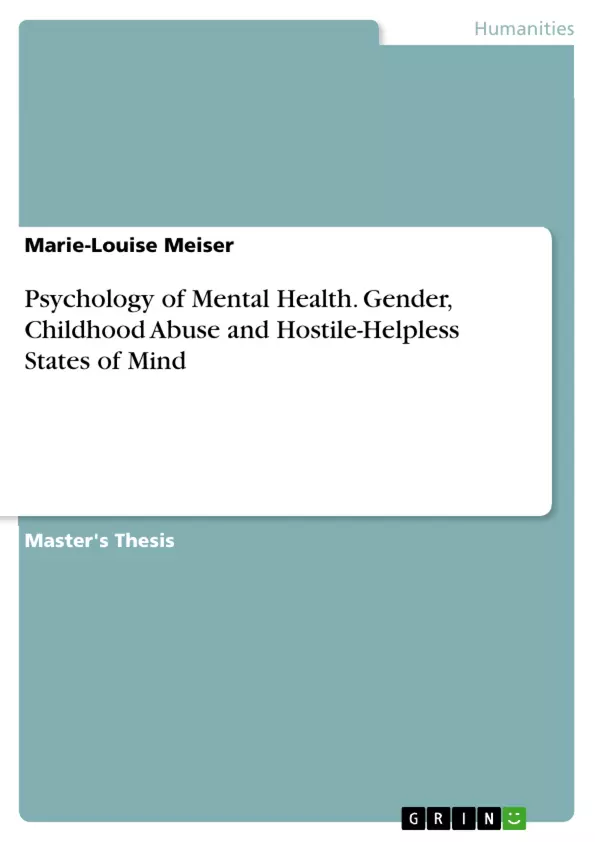The purpose of this study is to replicate the associations between severity of childhood abuse and punitive behaviour, and Hostile-Helpless (HH) states-of-mind; and to assess the gender-dependent effect of childhood abuse severity on HH states-of-mind via punitive behaviour. A secondary data set of longitudinally studied adolescents and their mothers was used. The study used interview and interaction measures as well as information from the state’s protective services.
HH states-of-mind levels in late adolescence have been repeatedly linked to higher severity of abuse in childhood, and to higher levels of adolescent punitive behaviour. To our knowledge, whether the link between severity of childhood abuse and adolescent HH states-of-mind is mediated by punitive behaviour has not yet been explored. Due to gender likely having an effect on the link, the present study aims to investigate whether the link between severity of childhood abuse and HH states-of-mind via punitive behaviour differs depending on gender, so that the effect is significant for females, but not males.
HH states-of-mind are a form of an adolescent’s or adult’s current representations of childhood attachment experiences. 'Attachment' describes the bond between an infant and their primary caregiver, and plays an important role in an individual’s functioning from cradle to grave. Infants are predisposed to seek closeness to their attachment figures – usually their predominant caregiver – to increase their chances of survival. In this infant-caregiver relationship, the infant forms a sense of self, and whether they can trust, and rely on their caregiver.
A caregiver’s display of frightening or frightened behaviour, or other forms of disrupted affective communication towards the infant, prevents the functional purposes of the attachment system: establishing proximity to the caregiver and reducing fear in stressful situations. Such behaviour can form a disorganized attachment relationship between the caregiver and their child, where the child externalizes their disorganized attachment by showing contradictory approach-avoidance behaviours towards
their caregiver.
Furthermore, disorganized attachment experiences can have a negative impact on the development of autonomy, and individual identity in adolescence. Thus, they can have adverse influences on the adolescent’s transition into adulthood as well as leading the development of HH states-of-mind.
Inhaltsverzeichnis (Table of Contents)
- Acknowledgements
- Table of Contents
- List of Figures
- List of Tables
- Abstract
- 1. Introduction
- 1.1 Hostile-Helpless (HH) States-of-Mind
- 1.2 Severity of Early Childhood Abuse
- 1.3 GPACS Punitive-Behaviour
- 1.4 Gender Differences
- 1.5 Aims and Hypotheses
- 2. Methods
- 2.1 Participants
- 2.2 Procedure
- 2.3 Measures
- 2.3.1 GPACS Punitive Behaviour
- 2.3.2 Hostile-Helpless States-of-Mind on the AAI
- 2.3.3 Overall Severity of Childhood Abuse
- 2.3.3.1 Traumatic Stress Schedule (TSS)
- 2.3.3.2 Childhood Traumatic Experiences Scale-Revised (CTES-R)
- 2.3.3.3 Conflict Tactics Scale - Second Version (CTS-2)
- 2.4 Analytical Strategy
- 3. Results
- 3.1 Descriptive Statistics
- 3.2 Correlations Between Study Variables
- 3.3 Differences Between Genders on Study Variables
- 3.4 Exploring the Potential Moderating Effect of Gender
- 3.5 Exploratory Analysis: Logistic Regression
- 4. Discussion
- 4.1 Limitations and Future Directions
- 4.2 Strengths
- 4.3 Implications
- Bibliography
Zielsetzung und Themenschwerpunkte (Objectives and Key Themes)
This research examines the relationship between severity of childhood abuse and hostile-helpless (HH) states-of-mind, exploring the potential moderating effect of gender. The study investigates the role of punitive behavior as a mediator in this relationship.
- Exploring the link between childhood abuse and hostile-helpless states-of-mind.
- Investigating the role of punitive behavior as a mediator in this relationship.
- Examining the moderating effect of gender on the link between childhood abuse and HH states-of-mind.
- Analyzing data using a moderated mediation model.
- Discussing the implications of findings for understanding the impact of childhood abuse and gender differences in mental health.
Zusammenfassung der Kapitel (Chapter Summaries)
- Chapter 1: Introduction: This chapter provides an overview of hostile-helpless (HH) states-of-mind, severity of early childhood abuse, and punitive behavior. It discusses the potential for gender differences in the relationship between these variables and outlines the aims and hypotheses of the study.
- Chapter 2: Methods: This chapter details the study's methodology, including participant characteristics, procedures, and the measures used to assess hostile-helpless states-of-mind, severity of childhood abuse, and punitive behavior.
- Chapter 3: Results: This chapter presents the findings of the study, including descriptive statistics, correlations between study variables, and the results of the moderated mediation analysis.
- Chapter 4: Discussion: This chapter discusses the implications of the study's findings, considering limitations, strengths, and future directions for research. It also explores the potential clinical implications of the results.
Schlüsselwörter (Keywords)
This study focuses on the relationship between childhood abuse, hostile-helpless states-of-mind, punitive behavior, and gender. Key concepts include: childhood trauma, attachment theory, adult attachment, psychological well-being, mental health, gender differences, moderated mediation, and the Adult Attachment Interview (AAI).
- Arbeit zitieren
- Marie-Louise Meiser (Autor:in), 2020, Psychology of Mental Health. Gender, Childhood Abuse and Hostile-Helpless States of Mind, München, GRIN Verlag, https://www.grin.com/document/1021147



